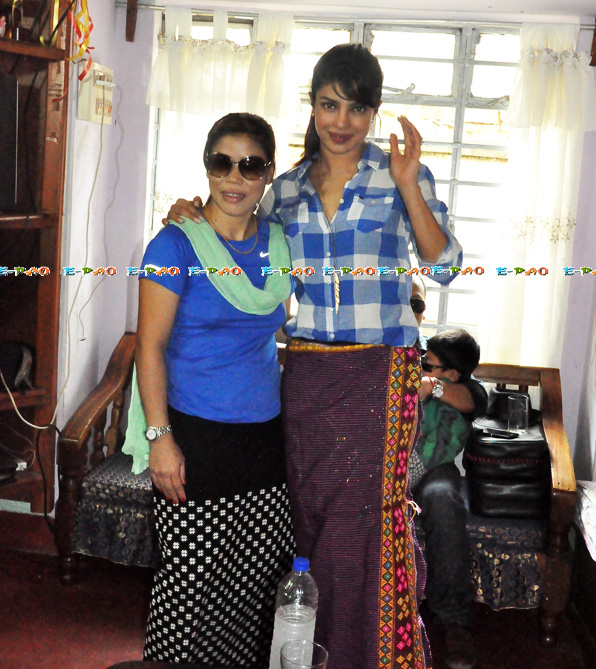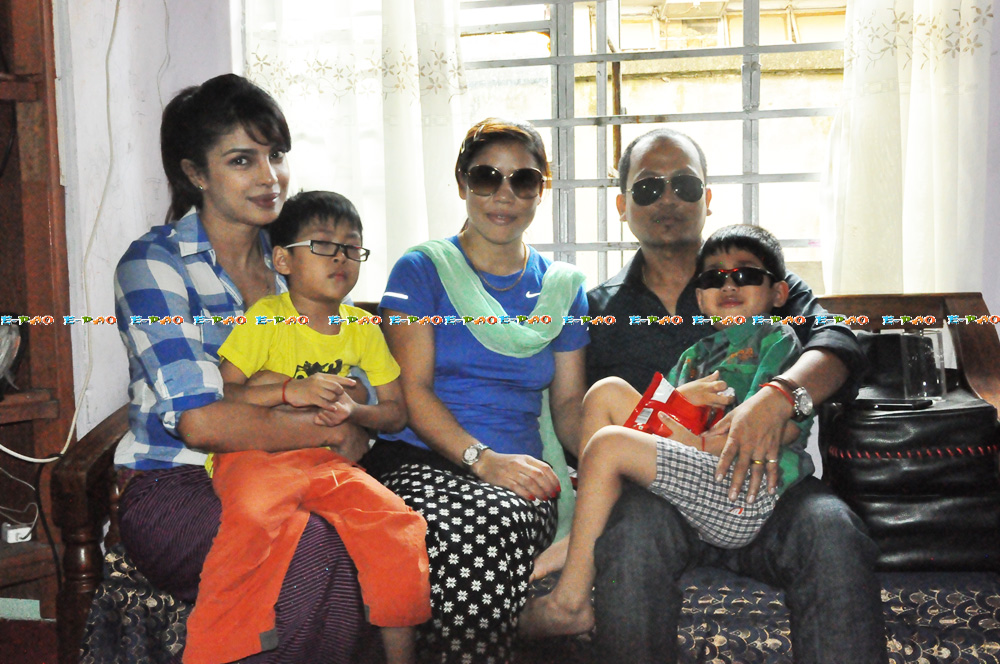Where is Mary Kom's Story?
Konsam Panthoi *

Miss World / Bollywood Superstar Priyanka Chopra visits Mary Kom at her Langol quarter on 15 July 2013
Picture Credit :: Jimmy
The recent Mary Kom movie has divided the whole nation into numerous camps with regard to different aspects of the movie. After the movie was released, topics of discussion and sometimes, arguments have increased from the questionable casting of Priyanka Chopra as Mary Kom to relatively irrelevant ones like location of the movie. The Mary Kom conundrum has led to clashes of ideologies but Mary Kom calls for discussions and not arguments.
One of the most controversial observations of the movie is the decision of the filmmakers to cast Priyanka Chopra as Mary Kom. Many have stated that an actor who has some resemblance to the real boxer, preferably from North-east India, should be casted as Kom. Others have defended the choice by invoking that ethnicity of Kom should be of the least concern as the most vital story is the rise of a poverty-ridden female-boxer in a sports dominated by men. Further, they strengthened their defence by focussing on the life of an Indian woman fighting the societal pressure of typecasting as a daughter, wife, and mother. All is well until they decide to ignore the story of a person belonging to the northeast.
Anyone from the northeast will understand and admit how imperative their Mongoloid features have been in their attempts to make their presence felt in the mainland. Kom herself has spoken publicly on racism and discrimination she faced because of the way she looks. The movie in selecting Chopra, thereby, decides not to deal with one of the most important issue many of us, including a celebrity like Kom, herself has faced. In a scene of the movie, the discriminatory attitude of the boxing officials and the reaction of Kom are shown. However, there is hardly any significance since we do not see discrimination of Mongoloid-looking people (implying, racism) but of a small-town girl, who can be from any part of the country. How will people understand racial discrimination and hence, what Kom had to go through if the movie completely alters the core cause?
In a country where the majority of the population is ignorant of its racial diversity, should we be content with just the mention of the word "Manipur" and a caricatured accent? What is more important- knowing there is a place called Manipur in India or there is a place called Manipur in North-eastern India, where people with Mongoloid features live. Often, racist attacks occur because of the ignorance about the geography and ethnicity of the country. At the same time, it is true that it is impossible to capture a person's life in a movie but the filmmakers' policy of exclusion and inclusion of certain parts of the subject's life finally shapes the movie.
The justification of the filmmakers and their supporters is that Chopra will guarantee box-office success of the movie, which will thus tell Kom's story to nooks and crannies of India. Ok, I agree but perhaps the only way to observe the effect/ impact of the movie is to find those who were introduced to Manipur, and Kom by the movie. Let us see whether they have any confusion regarding the fact that the real Kom has actually Mongoloid features and a language of her own (and not the accentuated Hindi), and is not a Punjabi girl brought up in the hills of the state of Manipur.
A friend accused me of being racist for dwelling too much on ethnicity. Her argument was, "We are all Indians. Why can't one Indian play another Indian?" Racism in India is indebted to socio-historical, political and cultural exclusion. It is about the constant denial to accept anything different from those perpetuated in the mainstream domain (Anyone belonging to any minority group will have no difficulty relating to this point). Promoting and accepting differences should never be sidelined or confused with the flawed theory of "unity in diversity". An attempt to establish a common thread and reject the definitive uniqueness in a cultural mosaic of a country like India, will subsequently lead to intolerance and rigidity. Expression of diversity should be encouraged and celebrated. What can be more simple and easy than beginning with the most tangible and visible aspect- one's physical appearance.
I have also been accused of promoting chauvinist regionalism and hence, being anti-Indian. However, the reason for writing this article extends beyond Manipur. It is for the same reason that I would never have watched Bhaag Milkha Bhaag had Hamom Sadananda or Bonny Gurumayum (no matter how talented they are) been cast in the role of a Sikh, Milkha Singh. If we go by this assumption, the despair of partition or the scene in which he goes back to his native place in Pakistan and cries his heart out would have had no impact on me and it would be been quite difficult to understand Milkha's situation. It is also for the same reason if someday Hollywood decides to film a biopic on the talented Chopra, and casts Jennifer Lawrence or Zoe Saldana just because of guaranteed international success, I will surely join the rest of the country in voicing against it. I can cite a thousand examples but the point is, it is simply outrageous! A few years ago, a commercial with Aston Kutcher as an Indian was pulled down following a strong negative response. Are not we being hypocritical here? Is it racist if it occurs in the US, but acceptable and even promotable in India?

Miss World / Bollywood Superstar Priyanka Chopra visits Mary Kom at her Langol quarter on 15 July 2013
Picture Credit :: Jimmy
Another cause of disagreement is that filmmaking is a business and Bollywood needs box-office result. Therefore, a popular talented actor like Chopra is perfect for the role. Without over-politicising the issue the fact is, Mary Kom can never be just about presentation without touching on the issue of representation. If the filmmakers say that they are selling a 'rise above all' story, doesn't it imply the same even with a North-eastern face? Is it unreasonably greedy to expect Bollywood to take a pinch of a risk and stop commercialising everything under the narrow-minded prejudice that the audience will never accept a northeastern face (I am not even touching the over-exploitation of sentiments in the movie!)? The arts are not merely depiction and reflection of our society and culture; it is a two-way street. Popular culture influences, as much as it is influenced by people and the lives they live.
In Manipur, the condition is something else. One cannot turn a blind eye on effects the ban of Hindi films has brought to artists wishing to work in Hindi films. In a recent interview, Tonthoi and Hijam Bala narrated the change in their career path owing to the ban. It is indeed sad to learn that Tonthoi, a National Award winner, had to drop an international project all because it was in Hindi. What is more depressing is that people had to flock to Guwahati to watch Mary Kom. In spite of the controversies and debates surrounding the film, people have the right to choose what they want to watch (do, follow, support and so on in the larger context). In such a scenario, our artists seem to be stuck in the middle, and just like the rest of the people, they have no say. To put it simply, Indian cinema is not ready to accept North-eastern faces and on the other, Manipuri artist are not allowed any artistic freedom.
Those questioning my purpose of writing this article with the amusing statement, "Who are you to write? It's Kom's life and her choice", should see that Kom's life crossed the private-public boundary the moment the signed the contract for the movie. Now, it is left to the audience to watch and exercise their freedom of expression. However, Kom should not carry the burden of the movie's social message and the underlying political issues. Her contribution to the country and to the society is perhaps more than any of us could ever dream of. I watched the movie only because of two reasons- my respect for Kom and my admiration for Chopra's acting. I never watched it as Kom's biopic since it is not. If someday Bollywood "understands" and "loves" us enough to film a biopic on Rani Gaidinliu, the only thing I hope and pray is they choose the cast more sensibly and sensitively and not bank on a Priyanka Chopra or a Katrina Kaif just for box-office success.
